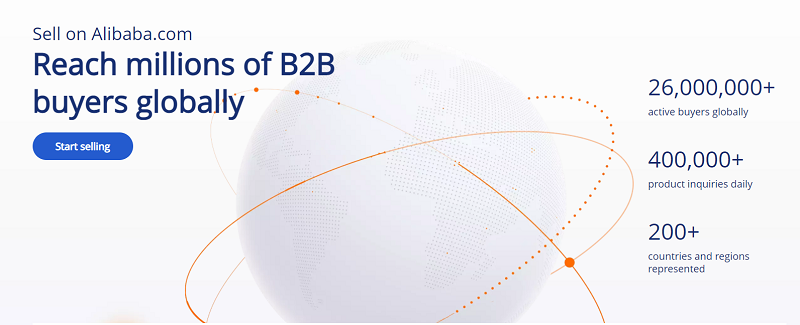How to use global supply chains to your business’ advantage

A global supply chain is a worldwide network created to source and supply goods and services. It typically spans multiple countries or continents and requires different activities, people, entities, information, and resources to function correctly.
Using a global supply chain is a profitable move for your manufacturing business, as it has many benefits. The exposure you give your business alone by entering into a global supply chain is more than enough reward. Fortunately, brand exposure is not the only benefit, as you also enjoy cost savings, a broader market, and profitable sales, to mention just a few.
This article discusses all you need to know about global supply chains, how your business can benefit from them, and how a leading global marketplace like Alibaba.com can help you on your journey.
Table of Contents
- How to use global supply chains to your business’ advantage
- What is a global supply chain?
- Examples of common global supply chain models
- Importance of global supply chains
- Ways to expand your business by entering into a global supply chain
- Advantages of selling on an online global marketplace
- Sell on Alibaba.com

What is a global supply chain?
What do Alibaba, Nike, and HP all have in common? If you thought of “global supply chains,” then you’re on the right track. A global supply chain allows huge multinationals to carry out business all over the world.
Fortunately, with the right knowledge and tools, you can also use a global supply chain — just as those giant companies do.
A supply chain consists of two key parts: sourcing and fulfillment.
The sourcing part of a global supply chain relates to manufacturing activities, such as purchasing the raw materials that make up a product. You can source the raw materials for your products either locally or internationally. It is the international sourcing of raw materials or components that takes your business from local to global.
The second part, fulfillment, deals with supplying goods to customers all over the world. Just as you can sell your company’s products locally, you can also expand your reach into international markets.
A typical supply chain involves producers, vendors, warehouses, managers, transportation companies, distribution centers, and retailers. These entities all play their part to ensure that a product goes from its raw form to its finished form, and finally arrives at the end-user.
A supply chain typically requires the following steps: [i]
- Broad planning by getting a birds-eye view of the entire process.
- Sourcing of raw materials.
- Manufacturing of the product. Essentially turning the raw materials into finished goods.
- Assembling and testing the product.
- Product packaging and warehousing in preparation for shipment.
- Taking the packed products from their initial destination to their final destination, by sea, air, or land.
- Loading the products into trucks and driving them to distribution centers, and from there, to the retailer or consumer.
What makes a supply chain global is that the steps involved occur across multiple countries. So, a manufacturing company can be part of a global supply chain by sourcing raw materials globally and selling its products locally, or sourcing raw materials locally and selling its products globally, or both.
A great example of a company operating both parts of a global supply chain is Apple. Apple sources the components that make up its products from all over the world. The company has over 200 suppliers[ii] and over 800 production facilities[iii] in countries including China, Taiwan, Brazil, and Vietnam, to mention a few.
By doing this, the company effectively reduces its production costs with the cheaper raw materials and labor in these regions compared with regions like North America and Europe.
The company does not stop there. It also markets its products in regions all over the world, which allows it to enter new and lucrative markets, even when local sales slow down.
Examples of common global supply chain models
There is no one-size-fits-all model for global supply chains. The model a company adopts depends on its structure and specific needs. Fortunately, there are several supply chain models to choose from. Some of them are:
- Continuous flow model: This is a mature supply chain model typically used by companies that consistently produce the same products, with little to no variation. Here, the company's products are often in high demand, and sales are often constant.
As a result, the company relies on supply and demand stability. In light of this, the process is designed to ensure a steady rhythm. Using this model, a company can streamline its production times, ensure there are no inventory shortfalls, and prevent supply chain bottlenecks.
- Fast chain model: Companies that sell trend-based products use this model. Since trends are fluid, these companies need to get their products to consumers as quickly as possible.
They rely on high forecast accuracy to reduce market mediation costs. They also invest in end-to-end efficiency, so their products are affordable for the consumer. If your company is trend-based, consider applying this supply chain model. Otherwise, by the time your product arrives, it might be out of style.
- Flexible model: This model works for those companies that manufacture seasonal products or products whose demand is unpredictable. Companies like this typically have periods of high demand and then long stretches of low workload. As a result, they are adaptable and can move quickly in response to increased demand or ramp down production when demand falls.

Importance of global supply chains
Taking your business beyond the borders of your country is a highly beneficial move. Businesses with global supply chains enjoy a broader market and can access cheaper or better-quality raw materials. You also stand to gain a competitive advantage over local rivals and increase the value of your brand.
Remember, for your company's global supply chain to deliver the results you desire, you should practice good supply chain management (SCM). Your supply chain should be designed to prevent or reduce shortages, risks, and supply chain bottlenecks that might threaten your business.
Now, let’s take a closer look at the benefits presented by global supply chains:
- Wider market: A global supply chain gives your business access to new and possibly more lucrative markets. It gives you the means to find fresh markets for your products and potentially create a global following for your brand. If you have considered strategies to scale your business, entering a global supply chain can set you on the path of faster growth.
- Cheaper production: Businesses that rely on global suppliers also have a better
opportunity to access competitive prices
- Competitive advantage: With cheaper production and lucrative new markets, your business is in a better position to compete with and even outperform local rivals. An efficient global supply chain allows you to avoid local production strains, operate with relative ease in international markets, and gain an edge over your competitors.
- Improved efficiency: With efficient SCM, your business enjoys a better negotiating position. You can obtain the best rates and products in the shortest time possible. This, in turn, helps reduce expenditure on inventory and improves the overall planning and efficiency of your operations.
- . For various reasons, such as inefficient local production or poor regulation, buying from local suppliers may be unduly expensive. With a global supply chain, you can locate suppliers with quality products and even compare vendors from various regions to find the best price possible.
[iv]
- Better sourcing options: A global supply chain opens up new avenues for product sourcing. You can take advantage of cutting-edge technology and products developed in markets outside your country. This way, you can innovate your business processes. You also get to enjoy access to a larger variety of materials than you would have had if you were operating strictly locally.
- Increased output rate and profit margins: Global markets can be voracious, meaning you get to supply more goods than you would have locally. In addition, to improve your business’ order fulfillment rates, a well-managed global supply chain gives you access to the best supply routes. In doing this, your business can also reduce shipping costs from exports, thus increasing your profit margin.
Now that you know just how beneficial global supply chains can be, let’s turn to how your business can get into one.
Ways to expand your business by entering a global supply chain
Before launching into how your business might exploit global supply chains, you should understand that transacting internationally is not without risks. Due to disruptions caused by the COVID-19 pandemic, international markets are wobbling a bit currently. A combination of factors such as high energy prices, port congestion, increased shipping costs, and labor shortages (such as a lack of truck drivers) have produced global supply chain woes.
But the good news is that countries worldwide are working hard to solve these supply chain issues. With the global economic recovery, and as countries exit lockdowns, global trade should recover. For instance, in the United States, the Biden Administration is working to remove port blockages and delays restricting the flow of goods. The government is also making plans to help its key West Coast ports stay open, such as in Los Angeles.[vi]
That said, here’s how to bring your business into the international scene and exploit the benefits of global supply chains:
- Do your research: The most essential factor about global supply chains is: they must be profitable for your business. So, make an effort to understand details such as the trade policies in your target region, the quality of suppliers there, applicable prices, etc. In addition, learn about the local laws surrounding business expansion and supply chain management in those regions.
- Identify and prepare against risks: Global supply chains can be vulnerable to risks as they are typically stretched over several countries and regions. For example, your supplier might become bankrupt, or supply chain disruptions in one region might deprive you of essential components.
On the fulfillment side, demand in global markets may fall because of local events, or unfriendly government policies may affect sales. However, many of these risks are foreseeable, and you should prepare against them when you can.
- Work collaboratively with your buyers and suppliers: Do not regard your suppliers as mere vendors. Instead, see them as partners who can provide insights and support as you scale your business. Your buyers can also give you valuable information that helps you shape your products and provide value. So, make an effort to obtain feedback from your buyers and suppliers. The insights you gain can help you:
- Optimize your supply chain
- Redesign your processes to reduce waste
- Purchase raw materials at wholesale prices
- Forecast, plan, and manage capacity
- Improve service levels
- Mitigate risks, including uncovering hidden risks and addressing them
- Strengthen the combined supply chain
- Leverage technology: One key way to do this is by selling on online global marketplaces like
- .

Advantages of selling on an online global marketplace
- More extensive customer base: An online marketplace makes it easier for you to reach new customers, meaning that you can expand your customer base. For instance,
- is home to thousands of buyers from hundreds of countries.
- Competitive advantage and better brand awareness: Exposure to thousands of customers will help your brand become stronger and more popular. When you combine this with a solid track record and dependable services, you can catapult your business into tremendous success.
- The KLT factor: These marketplaces typically have a Know, Like, and Trust (KLT) factor that has been built over time. When you sell on their platform, you can benefit from their goodwill as customers learn to trust your brand.
Sell on Alibaba.com
Alibaba.com is a leading global online marketplace with over 26 million active buyers globally, and over 400,000 product requests daily. Over 200 countries are represented on our platform, and their success stories testify to the value we bring to the table. So do your business a favor and scale it up by selling on Alibaba.com today.
References:
[i]. https://www.investopedia.com/terms/s/supplychain.asp
[ii]. https://www.apple.com/supplier-responsibility/pdf/Apple-Supplier-List.pdf
[iii]. https://www.investopedia.com/articles/investing/090315/10-major-companies-tied-apple-supply-chain.asp
[iv]. https://www.inboundlogistics.com/cms/article/5-tips-for-an-efficient-supply-chain-management/
Start your borderless business here
Tell us about your business and stay connected.
Keep up with the latest from Alibaba.com?
Subscribe to us, get free e-commerce tips, inspiration, and resources delivered directly to your inbox.














